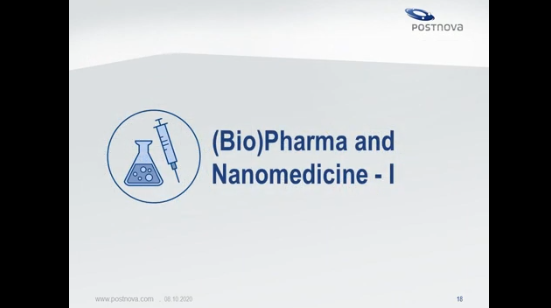The technique of Field-Flow Fractionation (FFF) is already known for several decades. It was invented in 1966 by Prof. Calvin Giddings, at the University of Utah in Salt Lake City, USA. Since the foundation of Postnova Analytics GmbH in 1997 the company developed new Field-Flow Fractionation separation and detection techniques. Nowadays FFF is a reliable analytical tool for the separation and comprehensive characterization in various fields of applications. Field-Flow Fractionation (FFF) is a flow-based separation technique for analytes in the nano- and lower micrometer size range.
The principle of the FFF technique is a separation field that is perpendicular to the laminar eluent flow in a separation channel or hollow fiber. The separation field can be a cross flow, a temperature gradient or a centrifugal field. Recently, a new FFF technology, Electrical Asymmetrical Flow Field-Flow Fractionation (EAF4), has been introduced where, in addition to a cross flow, an electrical field is simultaneously applied to the FFF separation channel.After the separation process within the channel the eluent flow transports the sample fractions toward respective detectors. Depending on the kind of requested information these detectors can be a concentration detector like a Refractive Index, a UV or a Fluorescence detector, or Light Scattering Detectors, like a Multi-Angle Light Scattering (MALS) or a Dynamic Light Scattering (DLS) detector, for size and molecular weight determination. The hyphenation to a viscometer detector provides structural information of polymers and the coupling to ICP-MS instruments facilitates the chemical identification of the sample constituents.
In 2020, Postnova Analytics further launched a Raman Flow Cell which enables the hyphenation of FFF to Raman microspectroscopy for a size resolved chemical identification of for example plastic particles. Besides the progressive development of hardware, also software improvement is a decisive factor for obtaining good measurement results. The NovaAnalysis software, which has been launched in 2020, improves both FFF method development, and evaluation of the obtained data.
This presentation will give insights into the broad application range of multi-detector FFF highlighting the undisputable merits of the hyphenation of a powerful FFF platform with advanced detection techniques. The application areas of FFF include (Bio)Pharma/Nanomedicine, Environment, Polymers and Nanoparticles, Cosmetic, Food and Agriculture. One of the presented studies shows the hyphenation of Electrical Asymmetrical Flow Field-Flow Fractionation (EAF4) to Multi-Angle Light Scattering detection (MALS), which allows the determination of size and surface charge of liposomal encapsulated doxorubicin , a well-established chemotherapeutic agent for cancer treatment. Another application out of the field of Nanomedicine is the quality control of Adeno-Associated Viruses (AAV). The coupling of AF4 to UV and MALS detection allows the quantification of aggregates in AAV samples, which would be filtered out in column based techniques due to their size. A further study illustrates the size determination and chemical identification of a mixture of plastic particles by coupling Centrifugal Field-Flow Fractionation (CF3) to MALS and Raman Microspectroscopy. Moreover a comparison of single particle ICP-MS (spICP-MS) and the hyphenation of Asymmetrical Flow Field-Flow Fractionation (AF4) to MALS and ICP-MS will be presented. The element specific characterization of silica particles by AF4-MALS-ICP-MS is possible for particle sizes far below the detection limit of spICP-MS.


